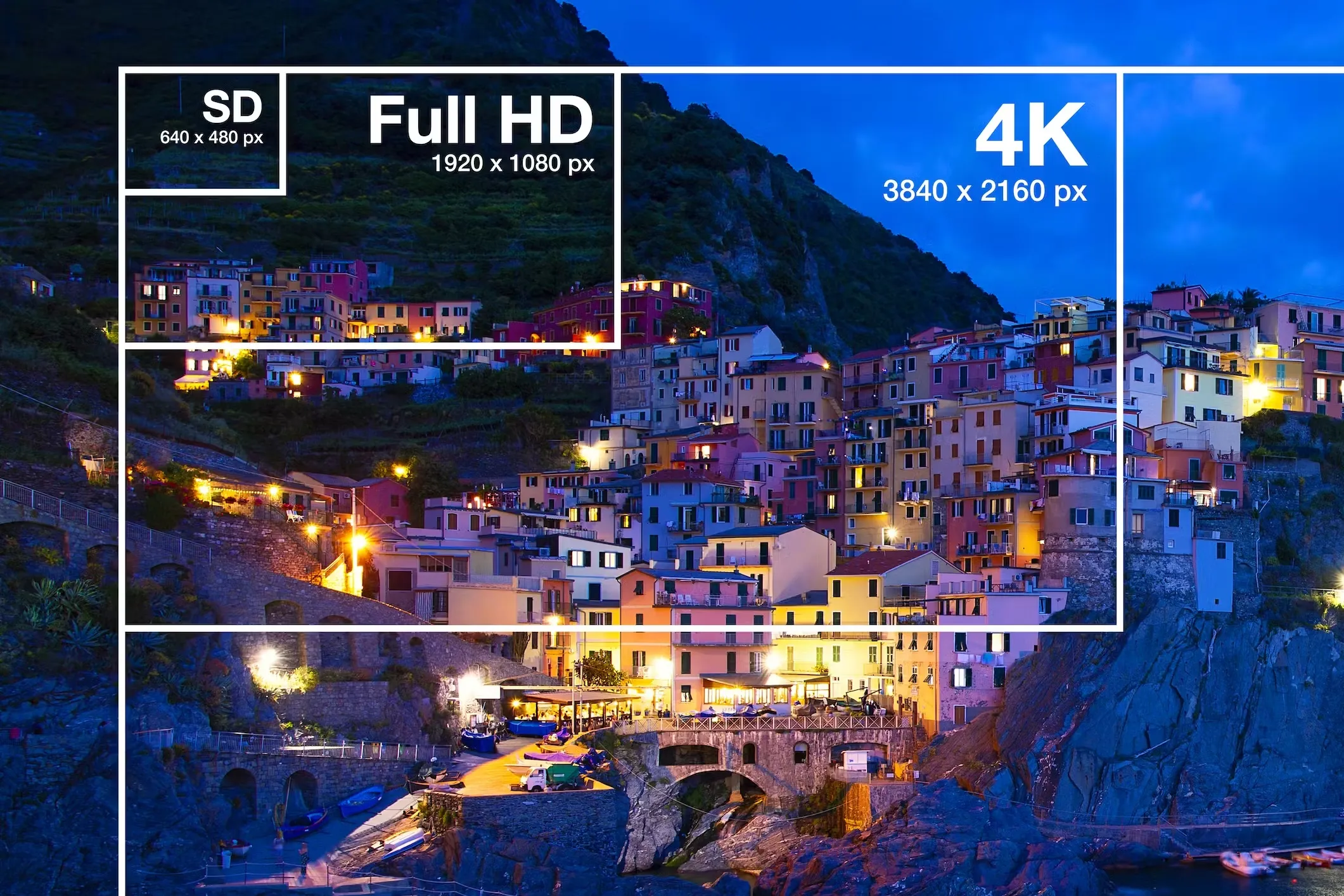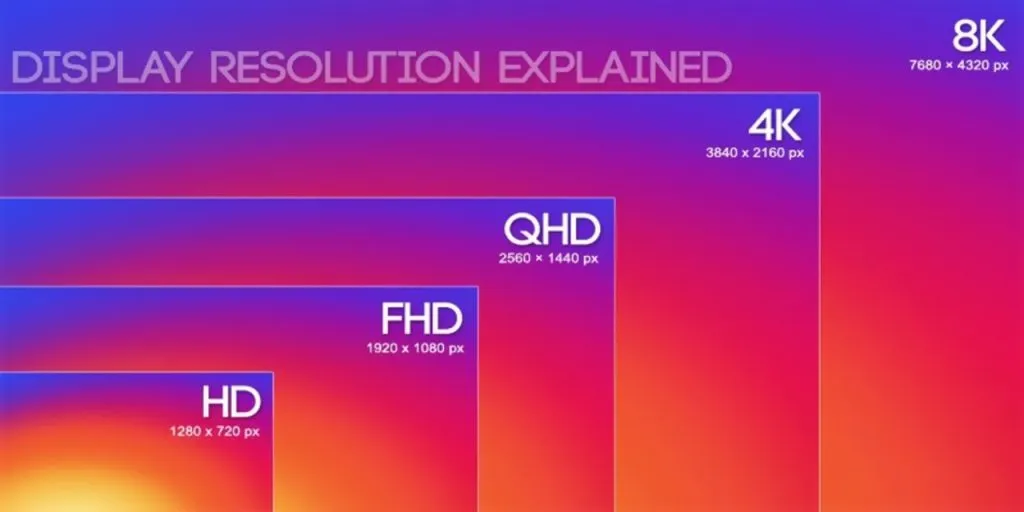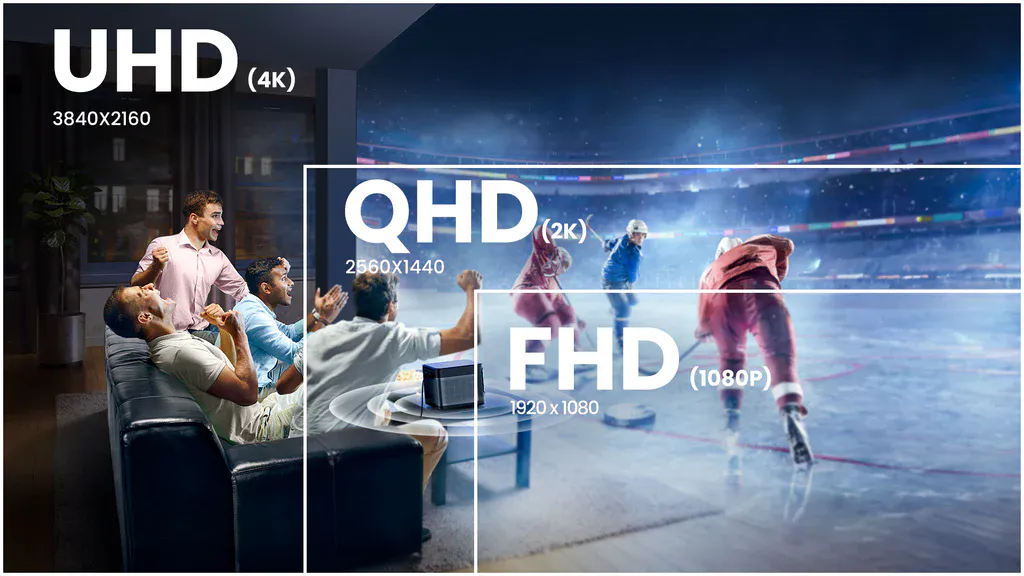What is SD, HD, UHD, 4K, 8K, DPI and How It Affects Your Device's Image Quality
Understand the difference between SD, HD, Full HD, 4K and 8K resolutions, DPI and how each impacts sharpness and visual quality on screens, TVs and monitors.
Have you ever wondered why some screens look sharper than others, even when they're the same size? The answer lies in resolution - a crucial factor that determines the visual quality of your devices. If you've been confused by terms like SD, HD, Full HD, 4K, and 8K, this guide will clear everything up in simple, practical terms.
Screen resolution defines how many pixels - tiny light points - it has to form images. The more pixels, the more detail and sharpness you'll get. It's like comparing a mosaic made with large pieces versus one made with tiny pieces - the second will always be more detailed and realistic.
In this article, you'll discover the main differences between each type of resolution, understand when each one is most suitable, and learn how to choose the best option for your specific needs, whether for watching movies, gaming, or working.
Table of Contents
- What are Pixels and How They Work
- SD (Standard Definition) - The Foundation
- HD (High Definition) - The First Quality Jump
- Full HD - Today's Standard
- Quad HD (2K) - The Bridge to the Future
- 4K UHD - The Visual Revolution
- 8K - The Limit of Human Perception
- DPI and Pixel Density
- How to Choose the Ideal Resolution
What are Pixels and How They Work
Before diving into different resolutions, it's essential to understand what pixels are. Pixels are tiny light points that, organized in a grid on the screen, form all the images you see. Think of a giant mosaic where each small colored piece is a pixel.
When we talk about HD resolution of 1280x720, we're referring to 1280 columns and 720 rows of pixels. Multiplying these numbers gives us approximately 921,600 pixels working together to create the image on your screen.
Visual quality depends directly on the density of these pixels. A screen with more pixels per square inch offers sharper and more detailed images. That's why a small smartphone can have Full HD resolution and look extremely sharp, while a large TV with the same resolution might appear less defined.
What's interesting is that resolution has no direct relationship to the physical screen size. A 6-inch smartphone can have 4K resolution, just like a 65-inch TV. The difference lies in pixel density and viewing distance.
Understanding how displays work is crucial for making informed decisions about your tech setup. If you're interested in learning more about the hardware that powers these displays, Code: The Hidden Language of Computer Hardware and Software provides an excellent foundation for understanding how computers process and display images.

SD (Standard Definition) - The Foundation
SD (Standard Definition) resolution represents 480p, with typical dimensions of 720×480 pixels in widescreen format or 640×480 pixels in 4:3 format. This was the standard resolution for old CRT TVs and is still found in some over-the-air TV broadcasts.
The name "Standard Definition" sounds dated today, as this resolution is considered low by current standards. It refers to the era when SD was actually the broadcasting standard, before the migration to high-definition digital systems in the early 2000s.
The main advantage of SD is its low internet bandwidth consumption, allowing smooth streaming even on slower connections. That's why many platforms still offer this option for users with limited internet. However, visual quality is significantly inferior, especially on larger screens.
For users dealing with limited bandwidth or older devices, SD still has its place. However, most modern streaming services have moved beyond SD as their base offering, recognizing that even basic internet connections can now handle higher resolutions reliably.
HD (High Definition) - The First Quality Jump
HD resolution represents 720p, with 1280×720 pixels in 16:9 widescreen format. This was the first major visual quality leap compared to SD, offering considerably sharper and more detailed images.
Although the term "High Definition" has lost some meaning with the emergence of higher resolutions, HD is still widely used. It's common in entry-level smartphones, basic tablets, and many cable TV broadcasts.
Versatility is HD's greatest strength. It offers satisfactory visual quality for portable devices without consuming as much bandwidth as higher resolutions. It's perfect for those who watch content on smaller screens or have internet limitations.
For larger devices like TVs, HD can show its limitations. With less than half the pixels of Full HD, the image may appear less sharp on screens above 32 inches, especially when you're close to the screen.
Many budget-friendly devices still use HD resolution effectively. If you're looking for affordable options, check out our guide on the best budget Android smartphones in 2025, many of which offer HD displays that work great for everyday use.
Full HD - Today's Standard
Full HD means 1920×1080 pixels, totaling over 2 million pixels per image. This has become the industry standard and is present in most current devices, from smartphones to TVs and monitors.
The BT-709-6 standard, established in 2015, defines that Full HD must have exactly 1,080 active lines with progressive scanning. This means each image frame is displayed completely, line by line, resulting in smoother and sharper images.
Full HD's visual quality is impressive for most uses. It offers sufficient detail for movies, games, and work, maintaining an ideal balance between quality and resource consumption. The difference from HD is easily noticeable, especially on larger screens.
The only consideration is higher storage and bandwidth consumption. A Full HD video takes up more than double the space of an equivalent HD video. For smartphones with limited storage, this can be limiting.
Full HD remains the sweet spot for most users. Whether you're setting up a home office or gaming setup, Full HD monitors and displays offer excellent value. For those interested in gaming displays, our guide to 144Hz gaming monitors covers many excellent Full HD options.
If you work with video editing or content production, it's worth learning more about how FPS affects your video quality, as resolution and frame rate work together to create the final visual experience.

Quad HD (2K) - The Bridge to the Future
Quad HD, also known as 2K, offers 2560×1440 pixels (1440p). The name "Quad" comes from having exactly four times more pixels than HD - hence the term "Quad HD". This resolution has become popular in premium smartphones and professional monitors.
With 3,686,400 pixels per frame, Quad HD offers superior visual quality to Full HD, especially noticeable on larger screens. The difference is more subtle than the HD to Full HD transition, but still significant for demanding users.
Quad HD's main advantage is in professional video editing. The extra pixels allow for cropping and digital zoom with less quality loss. It also enables more effective digital stabilization, as there's room to crop the edges without compromising final resolution.
For the average user, Quad HD offers a more refined visual experience, especially on smartphones. Higher pixel density results in sharper text and more detailed images. However, it consumes more battery and processing power.
Many professionals prefer Quad HD for productivity work. If you're building a workstation, consider pairing a Quad HD monitor with one of the best MacBooks available for excellent visual clarity in design and development work.
4K UHD - The Visual Revolution
4K UHD (Ultra High Definition) resolution features 3840×2160 pixels, four times more pixels than Full HD. This resolution has revolutionized the audiovisual industry and is becoming the new standard for TVs, monitors, and even premium smartphones.
There are different variations of 4K. 4K UHD (3840×2160) is the consumer standard, while 4K DCI (4096×2160) is used in the film industry. There are also ultrawide formats like Sony CinemaWide 4K for more immersive experiences.
4K didn't just bring more pixels, but also improvements in other visual technologies. HDR (High Dynamic Range), wider color gamuts, and better processing algorithms arrived alongside 4K, creating a truly superior visual experience.
To fully enjoy 4K, you need native content in this resolution. Fortunately, platforms like Netflix, Amazon Prime, and YouTube already offer extensive 4K catalogs. Netflix recommends a connection of at least 25 Mbps for uninterrupted 4K streaming.
The 4K revolution has also impacted mobile devices significantly. Many flagship smartphones now record and display 4K content. For those interested in mobile photography and videography, check out our guides on the best smartphones for recording videos and smartphones for photography in 2025.
For users setting up a complete 4K workflow, from capture to editing to display, understanding the underlying technology is crucial. How Computers Really Work: A Hands-On Guide to the Inner Workings of the Machine offers excellent insights into how modern processors handle high-resolution content.
8K - The Limit of Human Perception
8K resolution offers an impressive 7680×4320 pixels, totaling over 33 million pixels per image. This represents four times more pixels than 4K and sixteen times more than Full HD. It's an amount of detail that challenges the limits of human visual perception.
The 8K standard was defined by the BT.2020 specification in 2012, which also establishes 10 or 12-bit color depth and frame rates from 24 to 120 fps. 8K TVs have been available since 2015, but haven't gained widespread adoption due to high costs and lack of native content.
There's ongoing scientific debate about whether the human eye can actually distinguish between 4K and 8K under normal viewing conditions. Screen distance and size are crucial factors in perceiving the difference. On smaller screens or at normal distances, the difference may be imperceptible.
The main practical application of 8K today is "reframing" - the ability to crop in ultra-high resolution without losing quality. Since 8K has more vertical lines (4,320) than 4K has horizontal (3,840), you can even create vertical 4K crops without losing sharpness.
Content creators and professionals working with high-end video production are the primary beneficiaries of 8K technology currently. The format provides incredible flexibility in post-production, allowing for multiple camera angles from a single 8K source.

DPI and Pixel Density
DPI (Dots Per Inch) or PPI (Pixels Per Inch) measures how many pixels fit in a linear inch of the screen. This metric is fundamental to understanding why devices with the same resolution can have different visual qualities.
A 6-inch smartphone with Full HD resolution will have much higher density than a 40-inch TV with the same resolution. The smartphone will have approximately 367 PPI, while the TV will have only 55 PPI. That's why the smartphone will appear much sharper up close.
Ideal density varies according to usage distance. For smartphones, densities above 300 PPI are considered excellent. For TVs, which are viewed from a distance, densities between 30-80 PPI are sufficient. Computer monitors fall in an intermediate range, ideally between 90-150 PPI.
Apple popularized the term "Retina Display" for screens with sufficient density so that individual pixels aren't visible at normal usage distance. This density ranges from 220 PPI for tablets to 460 PPI for smartphones, depending on typical viewing distance.
Understanding pixel density is crucial when choosing devices for different purposes. For detailed work like photo editing or design, higher PPI displays make a significant difference. For general entertainment viewing, especially at appropriate distances, moderate pixel densities work perfectly well.
For professionals working with visual content, understanding the relationship between pixels and image rendering is fundamental for producing quality content.
How to Choose the Ideal Resolution
Choosing the ideal resolution depends on several factors that should be analyzed together: screen size, viewing distance, type of use, available budget, and internet infrastructure.
For smartphones, Full HD is still more than sufficient for screens up to 6 inches. Quad HD or 4K only make sense on larger screens or for very demanding users. Remember that higher resolutions consume more battery and processing power.
For TVs, 4K is practically mandatory for screens above 40 inches. For smaller screens, Full HD still offers excellent visual quality. 8K only makes sense on very large screens (above 65 inches) and for those who have access to native content.
For computer monitors, the choice depends on usage. Full HD is adequate for general use, Quad HD is ideal for productivity, and 4K is recommended for content creation or gaming. Also consider your graphics card's capabilities.
Don't forget about necessary infrastructure. 4K content requires fast internet and compatible devices. Verify that your devices support the desired resolution and that your connection supports high-quality streaming.
When building a complete setup, consider how all components work together. Our guides on laptops for work and study and tablets for entertainment can help you choose devices with appropriate displays for your needs.
For those looking to understand more about the technology behind these displays and how to optimize their performance, digital technology books offer comprehensive insights into display technology and optimization.
Modern smart home setups also benefit from understanding display technology. If you're interested in creating a connected home environment, check out our guide on the best smart home products compatible with Alexa, many of which feature high-resolution displays.
For those setting up home offices, the choice of display resolution can significantly impact productivity. Pair your high-resolution monitor with quality peripherals from our guides on ergonomic mice and compact mechanical keyboards for a complete workstation.
Understanding storage requirements is also crucial when working with high-resolution content. Learn more about how digital storage works to ensure you have adequate space for your high-resolution media files.
For gamers, display resolution works hand-in-hand with other specifications. Our guides on gaming smartphones and gaming monitors can help you understand how resolution affects gaming performance and experience.
If you're interested in understanding more about display technology and how it relates to internet connectivity, check out our comprehensive guide on internet speeds and WiFi technology to ensure your network can handle high-resolution streaming.

Conclusion
Understanding different screen resolutions is essential for making informed choices when buying electronic devices. Each resolution has its specific advantages and is suitable for different usage situations.
SD still serves slow connections, HD is versatile for portable devices, Full HD remains the reliable standard, Quad HD offers premium quality, 4K provides superior visual experience, and 8K represents the future of visual technology.
Remember: the best resolution is one that meets your specific needs without wasting resources. Always consider screen size, usage distance, type of content consumed, and your technological infrastructure before deciding.
Technology continues evolving, and new resolutions will emerge. But the fundamental concepts you've learned here will remain relevant for evaluating and choosing the best options for each situation.
Whether you're upgrading your home entertainment system, setting up a professional workstation, or simply trying to understand why some screens look better than others, this knowledge will help you make informed decisions that maximize both performance and value.
The key is matching resolution to your specific use case while considering the entire ecosystem of devices and content you'll be working with. As display technology continues advancing, these principles will guide you toward making smart choices that enhance your digital experience.
